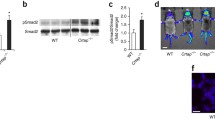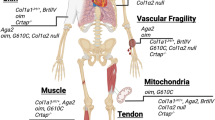Abstract
Classical osteogenesis imperfecta (OI) is a dominant genetic disorder of connective tissue caused by mutations in either of the two genes encoding type I collagen, COL1A1 and COL1A2. Recent investigations, however, have generated a new paradigm for OI incorporating many of the prototypical features that distinguish dominant and recessive conditions, within a type I collagen framework. We and others have shown that the long-sought cause of the recessive form of OI, first postulated in the Sillence classification, lies in defects in the genes encoding cartilage-associated protein (CRTAP) or prolyl 3-hydroxylase 1 (P3H1/LEPRE1). Together with cyclophilin B (PPIB), CRTAP and P3H1 comprise the collagen prolyl 3-hydroxylation complex, which catalyzes a specific posttranslational modification of types I, II, and V collagen, and may act as a general chaperone. Patients with mutations in CRTAP or LEPRE1 have a lethal to severe osteochondrodystrophy that overlaps with Sillence types II and III OI but has distinctive features. Infants with recessive OI have white sclerae, undertubulation of the long bones, gracile ribs without beading, and a small to normal head circumference. Those who survive to childhood or the teen years have severe growth deficiency and extreme bone fragility. Most causative mutations result in null alleles, with the absence or severe reduction of gene transcripts and proteins. As expected, 3-hydroxylation of the Pro986 residue is absent or severly reduced, but bone severity and survival length do not correlate with the extent of residual hydroxylation. Surprisingly, the collagen produced by cells with an absence of Pro986 hydroxylation has helical overmodification by lysyl hydroxylase and prolyl 4-hydroxylase, indicating that the folding of the collagen helix has been substantially delayed.
Similar content being viewed by others
References
Bachinger HP (1987) The influence of peptidyl-prolyl cis-trans isomerase on the in vitro folding of type III collagen. J Biol Chem 262:17144–17148
Bachinger HP, Bruckner P, Timpl R, Prockop DJ, Engel J (1980) Folding mechanism of the triple helix in type-III collagen and type-III pN-collagen. Role of disulfide bridges and peptide bond isomerization. Eur J Biochem 106:619–632
Bachinger HP, Ishikawa Y, Vranka JA, Wirz J, Pokidysheva E, Nagata K (2009) Biochemical characterization of the P3H1/CRTAP/CypB complex as a prolyl 3-hydroxylase, a PPIase and a molecular chaperone. 8th Pan-Pacific Connective Tissue Societies Symposium, Kanagawa, Japan
Baldridge D, Schwarze U, Morello R, Lennington J, Bertin TK, Pace JM, Pepin MG, Weis M, Eyre DR, Walsh J, et al (2008) CRTAP and LEPRE1 mutations in recessive osteogenesis imperfecta. Hum Mutat 29:1435–1442
Barnes AM, Chang W, Morello R, Cabral WA, Weis M, Eyre DR, Leikin S, Makareeva E, Kuznetsova N, Uveges TE, et al (2006) Deficiency of cartilage-associated protein in recessive lethal osteogenesis imperfecta. N Engl J Med 355:2757–2764
Bodian DL, Chan TF, Poon A, Schwarze U, Yang K, Byers PH, Kwok PY, Klein TE (2009) Mutation and polymorphism spectrum in osteogenesis imperfecta type II: implications for genotype-phenotype relationships. Hum Mol Genet 18:463–471
Brodeur AC, Wirth DA, Franklin CL, Reneker LW, Miner JH, Phillips CL (2007) Type I collagen glomerulopathy: postnatal collagen deposition follows glomerular maturation. Kidney Int 71:985–993
Bruschi M, Guerlesquin F (1988) Structure, function and evolution of bacterial ferredoxins. FEMS Microbiol Rev 4:155–175
Byers PH, Cole WG (2002) Osteogenesis imperfecta. In: Royce PM, Steinmann B (eds) Connective tissue and its heritable disorders. Wiley-Liss, New York, pp 385–430
Cabral WA, Chang W, Barnes AM, Weis M, Scott MA, Leikin S, Makareeva E, Kuznetsova NV, Rosenbaum KN, Tifft CJ, et al (2007) Prolyl 3-hydroxylase 1 deficiency causes a recessive metabolic bone disorder resembling lethal/severe osteogenesis imperfecta. Nat Genet 39:359–365
Cabral WA, Barnes AM, Rotimi CN, Brody L, Bailey-Wilson J, Panny SR, Chitayat D, Porter FD, Marini JC (2008) High carrier frequency of founder mutation causing severe/lethal recessive type VIII osteogenesis imperfecta in West Africans and African-Americans. 58th Annual Meeting of the American Society of Human Genetics, Philadelphia
Castagnola P, Gennari M, Morello R, Tonachini L, Marin O, Gaggero A, Cancedda R (1997) Cartilage associated protein (CASP) is a novel developmentally regulated chick embryo protein. J Cell Sci 110:1351–1359
Chessler SD, Byers PH (1993) BiP binds type I procollagen pro alpha chains with mutations in the carboxyl-terminal propeptide synthesized by cells from patients with osteogenesis imperfecta. J Biol Chem 268:18226–18233
Chines A, Boniface A, McAlister W, Whyte M (1995) Hypercalciuria in osteogenesis imperfecta: a follow-up study to assess renal effects. Bone 16:333–339
Chivers PT, Laboissiere MCA, Raines RT (1998) Protein disulfide isomerase: cellular enzymology of the CXXC motif. In: Guzman NA (ed) Prolyl hydroxylase, protein disulfide isomerase, and other structurally related proteins. Dekker, New York, pp 487–505
Coruzzi G, Tzagoloff A (1979) Assembly of the mitochondrial membrane system. DNA sequence of subunit 2 of yeast cytochrome oxidase. J Biol Chem 254:9324–9330
Fietzek PP, Rexrodt FW, Wendt P, Stark M, Kuhn K (1972) The covalent structure of collagen. Amino-acid sequence of peptide 1-CB6-C2. Eur J Biochem 30:163–168
Fischer G, Bang H, Mech C (1984) Determination of enzymatic catalysis for the cis-trans-isomerization of peptide binding in proline-containing peptides. Biomed Biochim Acta 43:1101–1111
Fischer G, Wittmann-Liebold B, Lang K, Kiefhaber T, Schmid FX (1989) Cyclophilin and peptidyl-prolyl cis-trans isomerase are probably identical proteins. Nature 337:476–478
Glerum DM, Shtanko A, Tzagoloff A (1996) SCO1 and SCO2 act as high copy suppressors of a mitochondrial copper recruitment defect in Saccharomyces cerevisiae. J Biol Chem 271:20531–20535
Holster T, Pakkanen O, Soininen R, Sormunen R, Nokelainen M, Kivirikko KI, Myllyharju J (2007) Loss of assembly of the main basement membrane collagen, type IV, but not fibril-forming collagens and embryonic death in collagen prolyl 4-hydroxylase I null mice. J Biol Chem 282:2512–2519
Horibe T, Gomi M, Iguchi D, Ito H, Kitamura Y, Masuoka T, Tsujimoto I, Kimura T, Kikuchi M (2004) Different contributions of the three CXXC motifs of human protein-disulfide isomerase-related protein to isomerase activity and oxidative refolding. J Biol Chem 279:4604–4611
Ishikawa Y, Wirz J, Vranka JA, Nagata K, Bachinger HP (2009) Biochemical characterization of the prolyl 3-hydroxylase 1/CRTAP/cyclophilin B complex. J Biol Chem 284:17641–17647
Kaul SC, Sugihara T, Yoshida A, Nomura H, Wadhwa R (2000) Gros1, a potential growth suppressor on chromosome 1: its identity to basement membrane-associated proteoglycan, leprecan. Oncogene 19:3576–3583
Kivirikko KI, Myllyla R (1979) Collagen glycosyltransferases. Int Rev Connect Tissue Res 8:23–72
Ko MK, Kay EP (2004) PDI-mediated ER retention and proteasomal degradation of procollagen I in corneal endothelial cells. Exp Cell Res 295:25–35
Koehler CM (2004) The small Tim proteins and the twin Cx3C motif. Trends Biochem Sci 29:1–4
Kojima T, Miyaishi O, Saga S, Ishiguro N, Tsutsui Y, Iwata H (1998) The retention of abnormal type I procollagen and correlated expression of HSP 47 in fibroblasts from a patient with lethal osteogenesis imperfecta. J Pathol 184:212–218
Labuda M, Morissette J, Ward LM, Rauch F, Lalic L, Roughley PJ, Glorieux FH (2002) Osteogenesis imperfecta type VII maps to the short arm of chromosome 3. Bone 31:19–25
Lauer M, Scruggs B, Chen S, Wassenhove-McCarthy D, McCarthy KJ (2007) Leprecan distribution in the developing and adult kidney. Kidney Int 72:82–91
Lehmann HW, Rimek D, Bodo M, Brenner RE, Vetter U, Worsdorfer O, Karbowski A, Muller PK (1995) Hydroxylation of collagen type I: evidence that both lysyl and prolyl residues are overhydroxylated in osteogenesis imperfecta. Eur J Clin Invest 25:306–310
Lisse TS, Thiele F, Fuchs H, Hans W, Przemeck GK, Abe K, Rathkolb B, Quintanilla-Martinez L, Hoelzlwimmer G, Helfrich M, et al (2008) ER stress-mediated apoptosis in a new mouse model of osteogenesis imperfecta. PLoS Genet 4:e7
Marini JC, Cabral WA, Barnes AM, Chang W (2007a) Components of the collagen prolyl 3-hydroxylation complex are crucial for normal bone development. Cell Cycle 6:1675–1681
Marini JC, Forlino A, Cabral WA, Barnes AM, San Antonio JD, Milgrom S, Hyland JC, Korkko J, Prockop DJ, De Paepe A, et al (2007b) Consortium for osteogenesis imperfecta mutations in the helical domain of type I collagen: regions rich in lethal mutations align with collagen binding sites for integrins and proteoglycans. Hum Mutat 28:209–221
Marutani T, Yamamoto A, Nagai N, Kubota H, Nagata K (2004) Accumulation of type IV collagen in dilated ER leads to apoptosis in Hsp47-knockout mouse embryos via induction of CHOP. J Cell Sci 117:5913–5922
Morello R, Tonachini L, Monticone M, Viggiano L, Rocchi M, Cancedda R, Castagnola P (1999) cDNA cloning, characterization and chromosome mapping of Crtap encoding the mouse cartilage associated protein. Matrix Biol 18:319–324
Morello R, Bertin TK, Chen Y, Hicks J, Tonachini L, Monticone M, Castagnola P, Rauch F, Glorieux FH, Vranka J, et al (2006) CRTAP is required for prolyl 3-hydroxylation and mutations cause recessive osteogenesis imperfecta. Cell 127:291–304
Myllyharju J, Kivirikko KI (2004) Collagens, modifying enzymes and their mutations in humans, flies and worms. Trends Genet 20:33–43
Obafemi AA, Bulas DI, Troendle J, Marini JC (2008) Popcorn calcification in osteogenesis imperfecta: incidence, progression, and molecular correlation. Am J Med Genet 146A:2725–2732
Phillips CL, Pfeiffer BJ, Luger AM, Franklin CL (2002) Novel collagen glomerulopathy in a homotrimeric type I collagen mouse (oim). Kidney Int 62:383–391
Piltti J, Hayrinen J, Karjalainen HM, Lammi MJ (2008) Proteomics of chondrocytes with special reference to phosphorylation changes of proteins in stretched human chondrosarcoma cells. Biorheology 45:323–335
Quan S, Schneider I, Pan J, Von Hacht A, Bardwell JC (2007) The CXXC motif is more than a redox rheostat. J Biol Chem 282:28823–28833
Rautavuoma K, Takaluoma K, Sormunen R, Myllyharju J, Kivirikko KI, Soininen R (2004) Premature aggregation of type IV collagen and early lethality in lysyl hydroxylase 3 null mice. Proc Natl Acad Sci USA 101:14120–14125
Risteli J, Tryggvason K, Kivirikko KI (1977) Prolyl 3-hydroxylase: partial characterization of the enzyme from rat kidney cortex. Eur J Biochem 73:485–492
Sillence DO, Senn A, Danks DM (1979) Genetic heterogeneity in osteogenesis imperfecta. J Med Genet 16:101–116
Steinmann B, Bruckner P, Superti-Furga A (1991) Cyclosporin A slows collagen triple-helix formation in vivo: indirect evidence for a physiologic role of peptidyl-prolyl cis-trans-isomerase. J Biol Chem 266:1299–1303
Stievano L, Piovan E, Amadori A (2004) C and CX3C chemokines: cell sources and physiopathological implications. Crit Rev Immunol 24:205–228
Tiainen P, Pasanen A, Sormunen R, Myllyharju J (2008) Characterization of recombinant human prolyl 3-hydroxylase isoenzyme 2, an enzyme modifying the basement membrane collagen IV. J Biol Chem 283:19432–19439
Tonachini L, Morello R, Monticone M, Skaug J, Scherer SW, Cancedda R, Castagnola P (1999) cDNA cloning, characterization and chromosome mapping of the gene encoding human cartilage associated protein (CRTAP). Cytogenet Cell Genet 87:191–194
Torre-Blanco A, Adachi E, Hojima Y, Wootton JA, Minor RR, Prockop DJ (1992) Temperature-induced post-translational over-modification of type I procollagen. Effects of over-modification of the protein on the rate of cleavage by procollagen N-proteinase and on self-assembly of collagen into fibrils. J Biol Chem 267:2650–2655
Tryggvason K, Majamaa K, Risteli J, Kivirikko KI (1979) Partial purification and characterization of chick-embryo prolyl 3-hydroxylase. Biochem J 183:303–307
Van Dijk FS, Nesbitt IM, Nikkels PG, Dalton A, Bongers EM, van de Kamp JM, Hilhorst-Hofstee Y, Den Hollander NS, Lachmeijer AM, Marcelis CL, et al (2009) CRTAP mutations in lethal and severe osteogenesis imperfecta: the importance of combining biochemical and molecular genetic analysis. Eur J Hum Genet (in press)
Vetter U, Maierhofer B, Muller M, Lang D, Teller WM, Brenner R, Frohneberg D, Worsdorfer O (1989) Osteogenesis imperfecta in childhood: cardiac and renal manifestations. Eur J Pediatr 149:184–187
Vranka JA, Sakai LY, Bachinger HP (2004) Prolyl 3-hydroxylase 1, enzyme characterization and identification of a novel family of enzymes. J Biol Chem 279:23615–23621
Vranka J, Stadler HS, Bachinger HP (2009) Expression of prolyl 3-hydroxylase genes in embryonic and adult mouse tissues. Cell Struct Funct 34:97-104
Walmsley AR, Batten MR, Lad U, Bulleid NJ (1999) Intracellular retention of procollagen within the endoplasmic reticulum is mediated by prolyl 4-hydroxylase. J Biol Chem 274:14884–14892
Ward LM, Rauch F, Travers R, Chabot G, Azouz EM, Lalic L, Roughley PJ, Glorieux FH (2002) Osteogenesis imperfecta type VII: an autosomal recessive form of brittle bone disease. Bone 31:12–18
Wassenhove-McCarthy DJ, McCarthy KJ (1999) Molecular characterization of a novel basement membrane-associated proteoglycan, leprecan. J Biol Chem 274:25004–25017
Willaert A, Malfait F, Symoens S, Gevaert K, Kayserili H, Megarbane A, Mortier G, Leroy JG, Coucke PJ, De Paepe A (2008) Recessive osteogenesis imperfecta caused by LEPRE1 mutations: clinical documentation and identification of the splice form responsible for prolyl 3-hydroxylation. J Med Genet 46:233–241
Williams EM, Nicholls AC, Daw SC, Mitchell N, Levin LS, Green B, MacKenzie J, Evans DR, Chudleigh PA, Pope FM (1989) Phenotypical features of an unique Irish family with severe autosomal recessive osteogenesis imperfecta. Clin Genet 35:181–190
Wilson R, Freddi S, Chan D, Cheah KS, Bateman JF (2005) Misfolding of collagen X chains harboring Schmid metaphyseal chondrodysplasia mutations results in aberrant disulfide bond formation, intracellular retention, and activation of the unfolded protein response. J Biol Chem 280:15544–15552
Author information
Authors and Affiliations
Corresponding author
Rights and permissions
About this article
Cite this article
Marini, J.C., Cabral, W.A. & Barnes, A.M. Null mutations in LEPRE1 and CRTAP cause severe recessive osteogenesis imperfecta. Cell Tissue Res 339, 59–70 (2010). https://doi.org/10.1007/s00441-009-0872-0
Received:
Accepted:
Published:
Issue Date:
DOI: https://doi.org/10.1007/s00441-009-0872-0




